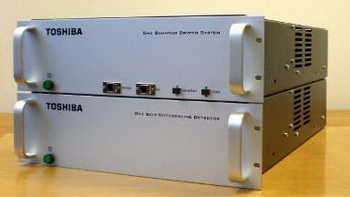OOPS! You forgot to upload swfobject.js ! You must upload this file for your form to work.
A new method of quantum encryption over fiber optic networks
![]()
|
xtreview is your : Video card - cpu - memory - Hard drive - power supply unit source |
|
|||
|
|
||||
 Recommended : Free unlimited image hosting with image editor
Recommended : Free unlimited image hosting with image editor
|
POSTER: computer news || A NEW METHOD OF QUANTUM ENCRYPTION OVER FIBER OPTIC NETWORKS |
DATE:2012-11-26 |
|
|
Employees of the Research Laboratory of Cambridge together with experts from Toshiba Corporation have developed a new way to protect quantum information transmitted over the Internet . The principle of quantum cryptography is based on the bit-wise information coding digital key from a single photon. If a hacker intercepts the photon, it inevitably violates coding that immediately detects an intruder. Previously, such an encoding required to send photons through a separate layer of optical fibers, which required additional lines of communication (probably military and government networks today use such methods of protection).  The results of a joint study of Cambridge and Toshiba - their importance lies in the fact that they allow to send a signal through encrypting common fiber optic cable, without the need to expand infrastructure. Needless ciphering equipment, according to Toshiba, will be relatively inexpensive, and certainly this development will become popular in the e-money circulation and exchange of private or corporate information. Related Products : | ||
|
|
||
|
xtreview is your : Video card - cpu - memory - Hard drive - power supply unit source |
|
|
|
|
||
|
Xtreview Support  N-Post:xxxx Xtreview Support        |
A NEW METHOD OF QUANTUM ENCRYPTION OVER FIBER OPTIC NETWORKS |
| Please Feel Free to write any Comment; Thanks  |
The new version of GPU-Z finally kills the belief in the miracle of Vega transformation (2017-09-08)
Pre-orders for new iPhone start next week (2017-09-07)
New Kentsfield overclocking record up to 5204 MHz (2017-09-07)
Panasonic P9 a new Android-smartphone entry-level (2017-09-07)
China banned the creation of new ICO crypto-currency and ordered to return the money for the created one (2017-09-06)
Radeon R9 280 new records (2017-09-06)
Core i9-7960X at 5750 MHz set a new record for XTU (2017-08-28)
New photos of Android-smartphone LG V30 (2017-08-28)
A new round of video card price hike is triggered by a rise in prices for memory chips (2017-08-28)
With the memory of SK Hynix new hopes for the normalization of prices for Radeon RX Vega 64 (2017-08-24)
Special price when buying three graphics cards a new way to deal with miners (2017-08-22)
Analysts believe that the new processors from Intel and AMD will revive the PC market in the second half of the year (2017-08-22)
New driver improved voltage management for Radeon RX Vega (2017-08-22)
Meet the new version of the popular secure smartphone AGM X2 (2017-08-19)
Intel and BMW gather around themselves new partners to develop robots (2017-08-17)
Intel introduced a new form factor for SSD servers line (2017-08-10)
For the new absolute Cinebench R15 record, 88 Broadwell-EX cores (2017-08-10)
Developers Borderlands announced a new competitive first person shooter (2017-08-08)
The new Android-tablet Huawei Honor is certified by TENAA (2017-08-05)
Tesla receives 1800 new orders for Model 3 daily (2017-08-03)
![]()
To figure out your best laptops .Welcome to XTreview.com. Here u can find a complete computer hardware guide and laptop rating .More than 500 reviews of modern PC to understand the basic architecture


7600gt review
7600gt is the middle card range.
We already benchmarked this video card and found that ...

 geforce 8800gtx and 8800gts
geforce 8800gtx and 8800gts  Xtreview software download Section
Xtreview software download Section  AMD TURION 64 X2 REVIEW
AMD TURION 64 X2 REVIEW  INTEL PENTIUM D 920 , INTEL PENTIUM D 930
INTEL PENTIUM D 920 , INTEL PENTIUM D 930  6800XT REVIEW
6800XT REVIEW  computer hardware REVIEW
computer hardware REVIEW  INTEL CONROE CORE DUO 2 REVIEW VS AMD AM2
INTEL CONROE CORE DUO 2 REVIEW VS AMD AM2  INTEL PENTIUM D 805 INTEL D805
INTEL PENTIUM D 805 INTEL D805  Free desktop wallpaper
Free desktop wallpaper  online fighting game
online fighting game  Xtreview price comparison center
Xtreview price comparison center Lastest 15 Reviews


Rss Feeds
Last News
- The new version of GPU-Z finally kills the belief in the miracle of Vega transformation
- The motherboard manufacturer confirms the characteristics of the processors Coffee Lake
- We are looking for copper coolers on NVIDIA Volta computing accelerators
- Unofficially about Intels plans to release 300-series chipset
- The Japanese representation of AMD offered monetary compensation to the first buyers of Ryzen Threadripper
- This year will not be released more than 45 million motherboards
- TSMC denies the presentation of charges from the antimonopoly authorities
- Radeon RX Vega 64 at frequencies 1802-1000 MHz updated the record GPUPI 1B
- AMD itself would like to believe that mobile processors Ryzen have already been released
- AMD Vega 20 will find application in accelerating computations
- Pre-orders for new iPhone start next week
- Radeon RX Vega 57, 58 and 59: the wonders of transformation
- ASML starts commercial delivery of EUV-scanners
- The older Skylake processors with a free multiplier are removed from production
- Meizu will release Android-smartphone based on Helio P40
- AMD Bristol Ridge processors are also available in American retail
- The fate of Toshiba Memory can be solved to the next environment
- duo GeForce GTX 1080 Ti in GPUPI 1B at frequencies of 2480-10320 MHz
- New Kentsfield overclocking record up to 5204 MHz
- Lenovo released Android-smartphone K8

HALO 3 HALO 3 - Final Fight!

PREY Prey is something you don t often see anymore: a totally unigue shooter experience.

computer news computer parts review Old Forum Downloads New Forum Login Join Articles terms Hardware blog Sitemap Get Freebies


